A Road Map to Detect the Foremost 3E Potential Areas for Installation of PV Façade Technology Using Multi-Criteria Decision Making
Abstract
1. Introduction
1.1. Motivation
1.2. Literature Review
1.3. Gap and Novelty
- In the past, there has been no study regarding the systematic approach in order to determine the best place to use BIPV/T systems. It means in the studies in which more than one city has been investigated, no decision-making approach was utilized to find the best potential case.
- Providing a method to determine the preference for installation of BIPV/T technologies among a number of candidate locations. It is carried out using TOPSIS, as a systematic approach for this purpose (the word “systematic” means it could be employed for each and every case). The electricity generation and heat recovery in a year from the energy side, PBP and LCOE from the economic viewpoint, as well as the carbon dioxide savings from the environmental side, are taken into account as the decision criteria. They are the key performance indicators of an energy system such as BIPV/T technology.
1.4. Structure of Paper
2. Materials and Methods
2.1. System Description
2.2. Studied Cities
2.3. Modelling
2.3.1. Energy Analysis
Glass Layer
- The solar radiation;
- The heat transfer from conduction type between top EVA and glass layers;
- The heat transfer from convection type between glass and surroundings;
- Radiation between glass and the environment.
Top EVA Layer
- The heat transfer from conduction type between top EVA and glass layers;
- The heat transfer from conduction type between top EVA and PV layers.
Silicon Layer
- Radiation from the sun;
- Power production;
- The heat transfer from conduction type between top EVA and PV layers;
- The heat transfer from conduction type between bottom EVA and PV layers.
Lower EVA Layer
- Conductive heat transfer between bottom EVA and Silicon layers;
- Conductive heat transfer between bottom EVA and Tedlar layers.
Lower EVA Layer
- Conductive heat transfer between bottom EVA and Tedlar layers;
- The convective heat transfer between Tedlar and surroundings;
- Radiation between Tedlar and the environment.
2.3.2. Economic Analysis
Payback Period
- Selling electricity to the grid. In that term, , , , and are electricity produced throughout the year, selling electricity price to the grid per unit, the annual inflation rate in electricity price, life time of system, and the interest rates;
- Revenues from savings in the natural gas consumption. Here, , , , and are the lower heating value, density, cost of fuel per unit, and the annual inflation rate in electricity price, respectively. and are also the heat recovery in a year and conventional system efficiency. The conventional system could be a hot water system and recovering heat from PV panels leads to its natural gas consumption;
- Initial costs;
- Maintenance cost is equal to 0.02 of the initial system costs in the first year of operation [44]. It has an inflation of .
Levelized Cost of Energy (LCOE)
2.3.3. Environmental Modeling
2.4. TOPSIS Decision-Making Method
- Electricity production during a year;
- Heat recovery during a year (the annual heat recovery means the amount heat recovered during the heating season (Annual heat recovery = Heating season heat recovery + Other seasons heat recovery = Heating season heat recovery + 0 = Heating season heat recovery));
- LCOE;
- PBP;
- Carbon dioxide saving during a year.
3. Results and Discussion
3.1. Validation
3.2. Monthly Profiles
3.3. Annual Performance Indicators
4. Conclusions
- The cities with high ambient temperature and high received solar irradiance. For such cities, the amount of heat recovery and electricity generation, and consequently, carbon dioxide savings, are in the best condition among all the cities. Yazd was best representative of all the cities with such specifications. It gained the normalized closeness index of 27.4 out of 100;
- The cities with great natural gas and electricity tariffs, as well as high O&M cost. Tehran was the best representative of all the cities. TOPSIS gave a closeness index of 26.0 out of 100 to Tehran. For such cities, PBP and LCOE are of the foremost conditions in comparison to other alternatives.
Author Contributions
Funding
Institutional Review Board Statement
Informed Consent Statement
Data Availability Statement
Conflicts of Interest
Nomenclature
| Area () | |
| Isobaric heat transfer () | |
| Cost | |
| CLI | Closeness index |
| Discount rate (%) | |
| Hydraulic diameter | |
| irradiance () | |
| Inflation rate (%) | |
| Length () | |
| thermal conductivity () | |
| Obj | Onbjective |
| Year | |
| Power () | |
| Prandtl number | |
| R | Thermal resistance |
| Re | Reynolds number |
| Time () | |
| Temperature () | |
| Velocity () | |
| Wind speed () | |
| Greek symbols | |
| Absorptivity | |
| Temperature coefficient | |
| Thickness () | |
| Emissivity | |
| Density () | |
| Kinetic viscosity | |
| Efficiency (%) | |
| Transmissivity | |
| Scripts | |
| Ambient | |
| Conduction | |
| Convection | |
| Ethylene vinyl acetate | |
| ele | Electricity |
| Glass | |
| ideal | Ideal |
| Natural gas | |
| num | Number |
| Operating and maintenance | |
| Radiation | |
| Reference | |
| Sky | |
| Td | Tedlar |
| Abbreviation | |
| BIPV | Building integrated photovoltaic |
| LCOE | Levelized cost of energy |
| LHV | Lower heating value |
| PBP | Payback period |
References
- Zhang, Y.; Lu, J.; Jiang, X.; Shen, S.; Wang, X. A study on heat transfer load in large space buildings with stratified air-conditioning systems based on building energy modeling: Model validation and load analysis. Sci. Prog. 2021, 104, 00368504211036133. [Google Scholar] [CrossRef] [PubMed]
- Sohani, A.; Dehnavi, A.; Sayyaadi, H.; Hoseinzadeh, S.; Goodarzi, E.; Garcia, D.A.; Groppi, D. The real-time dynamic multi-objective optimization of a building integrated photovoltaic thermal (BIPV/T) system enhanced by phase change materials. J. Energy Storage 2021, 46, 103777. [Google Scholar] [CrossRef]
- Hoseinzadeh, S.; Garcia, D.A. Techno-economic assessment of hybrid energy flexibility systems for islands’ decarbonization: A case study in Italy. Sustain. Energy Technol. Assess. 2021, 51, 101929. [Google Scholar] [CrossRef]
- Sohani, A.; Cornaro, C.; Shahverdian, M.H.; Samiezadeh, S.; Hoseinzadeh, S.; Dehghani-Sanij, A.; Pierro, M.; Moser, D. Using Building Integrated Photovoltaic Thermal (BIPV/T) systems to achieve net zero goal: Current trends and future perspectives. In Towards Net Zero Carbon Emissions in the Building Industry; Sayigh, A., Ed.; Springer International Publishing: Cham, Switzerland, 2022; pp. 91–107. [Google Scholar]
- Lv, L.; Xiang, Y.; Gu, Z.; Huang, C. Dynamic characteristics of convection heat and radiation heat on building surfaces under cyclic heat flow. Sci. Prog. 2022, 105, 00368504221075189. [Google Scholar] [CrossRef] [PubMed]
- Razmjoo, A.; Mirjalili, S.; Aliehyaei, M.; Østergaard, P.A.; Ahmadi, A.; Nezhad, M.M. Development of smart energy systems for communities: Technologies, policies and applications. Energy 2022, 248, 123540. [Google Scholar] [CrossRef]
- Mahmoudan, A.; Esmaeilion, F.; Hoseinzadeh, S.; Soltani, M.; Ahmadi, P.; Rosen, M. A geothermal and solar-based multigeneration system integrated with a TEG unit: Development, 3E analyses, and multi-objective optimization. Appl. Energy 2021, 308, 118399. [Google Scholar] [CrossRef]
- Lv, L.; Luo, Y.; Xiang, Y.; Zhou, X.; Huang, C. Research on the dynamic heat transfer of stratified air conditioning zone building surfaces in large space scale rig based on low supply-middle return. Sci. Prog. 2020, 103, 0036850420950926. [Google Scholar] [CrossRef]
- Gong, X.; Chen, Y.; Liang, M. Theoretical study of building-integrated photovoltaics based on perovskite single junction and perovskite/silicon tandem solar cells. Energy Explor. Exploit. 2019, 38, 723–732. [Google Scholar] [CrossRef]
- Sohani, A.; Naderi, S.; Pignatta, G. 4E Advancement of Heat Recovery during Hot Seasons for a Building Integrated Photovoltaic Thermal (BIPV/T) System. Environ. Sci. Proc. 2021, 12, 5. [Google Scholar]
- Riaz, A.; Liang, R.; Zhou, C.; Zhang, J. A review on the application of photovoltaic thermal systems for building façades. Build. Serv. Eng. Res. Technol. 2019, 41, 86–107. [Google Scholar] [CrossRef]
- Kong, F. A better understanding of the role of new energy and green finance to help achieve carbon neutrality goals, with special reference to China. Sci. Prog. 2022, 105, 00368504221086361. [Google Scholar] [CrossRef] [PubMed]
- Riaz, A.; Zhou, C.; Liang, R.; Zhang, J. Performance study on photovoltaic thermal building façade component in multi-energy generation during winter. Build. Serv. Eng. Res. Technol. 2021, 42, 405–419. [Google Scholar] [CrossRef]
- Karthick, A.; Murugavel, K.K.; Sudalaiyandi, K.; Manokar, M. Building integrated photovoltaic modules and the integration of phase change materials for equatorial applications. Build. Serv. Eng. Res. Technol. 2019, 41, 634–652. [Google Scholar] [CrossRef]
- Pugsley, A.; Zacharopoulos, A.; Chemisana, D. Chapter 10—Polygeneration systems in buildings. In Polygeneration Systems; Calise, F., Dentice D’Accadia, M., Vanoli, L., Vicidomini, M., Eds.; Academic Press: Cambridge, MA, USA, 2022; pp. 351–410. [Google Scholar]
- Rahiminejad, M.; Pâris, A.L.M.; Ge, H.; Khovalyg, D. Performance of lightweight and heavyweight building walls with naturally ventilated passive and active facades. Energy Build. 2021, 256, 111751. [Google Scholar] [CrossRef]
- Theokli, C.; Elia, C.; Markou, M.; Vassiliades, C. Energy renovation of an existing building in Nicosia Cyprus and investigation of the passive contribution of a BIPV/T double façade system: A case-study. Energy Rep. 2021, 7, 8522–8533. [Google Scholar] [CrossRef]
- Pillai, D.S.; Shabunko, V.; Krishna, A. A comprehensive review on building integrated photovoltaic systems: Emphasis to technological advancements, outdoor testing, and predictive maintenance. Renew. Sustain. Energy Rev. 2022, 156, 111946. [Google Scholar] [CrossRef]
- Dash, A.; Agrawal, S.; Gairola, S.; Singh, S. Optimization and Performance Characteristics of Building Integrated Photovoltaic Thermal (BIPVT) System in Cold Climatic Conditions. Asian J. Water, Environ. Pollut. 2018, 15, 63–72. [Google Scholar] [CrossRef]
- Garg, S. Developing a BIPVT: Building Integrated PV-Thermal System. Master’s Thesis, Delft University of Technology, Delft, The Netherlands, 2018. [Google Scholar]
- Lamnatou, C.; Smyth, M.; Chemisana, D. Building-Integrated Photovoltaic/Thermal (BIPVT): LCA of a façade-integrated prototype and issues about human health, ecosystems, resources. Sci. Total Environ. 2019, 660, 1576–1592. [Google Scholar] [CrossRef]
- Kazemian, A.; Salari, A.; Hakkaki-Fard, A.; Ma, T. Numerical investigation and parametric analysis of a photovoltaic thermal system integrated with phase change material. Appl. Energy 2019, 238, 734–746. [Google Scholar] [CrossRef]
- Yu, G.; Yang, H.; Yan, Z.; Ansah, M.K. A review of designs and performance of façade-based building integrated photovoltaic-thermal (BIPVT) systems. Appl. Therm. Eng. 2020, 182, 116081. [Google Scholar] [CrossRef]
- Jahangir, M.H.; Razavi, S.M.E.; Kasaeian, A.; Sarrafha, H. Comparative study on thermal performance of an air based photovoltaic/thermal system integrated with different phase change materials. Sol. Energy 2020, 208, 1078–1090. [Google Scholar] [CrossRef]
- Shakouri, M.; Ghadamian, H.; Noorpoor, A. Quasi-dynamic energy performance analysis of building integrated photovoltaic thermal double skin façade for middle eastern climate case. Appl. Therm. Eng. 2020, 179, 115724. [Google Scholar] [CrossRef]
- Bot, K.; Aelenei, L.; Da Glória Gomes, M.; Silva, C.S. Performance Assessment of a Building Integrated Photovoltaic Thermal System in Mediterranean Climate—A Numerical Simulation Approach. Energies 2020, 13, 2887. [Google Scholar] [CrossRef]
- Kumar, N.M.; Samykano, M.; Karthick, A. Energy loss analysis of a large scale BIPV system for university buildings in tropical weather conditions: A partial and cumulative performance ratio approach. Case Stud. Therm. Eng. 2021, 25, 100916. [Google Scholar] [CrossRef]
- Rounis, E.D.; Athienitis, A.K.; Stathopoulos, T. BIPV/T curtain wall systems: Design, development and testing. J. Build. Eng. 2021, 42, 103019. [Google Scholar] [CrossRef]
- Dumoulin, R.; Rounis, E.D.; Athienitis, A. Operation and grid interaction modeling of a house with a building integrated photovoltaic thermal (BIPV/T) system coupled to an air-source heat pump. Sci. Technol. Built Environ. 2021, 27, 1311–1329. [Google Scholar] [CrossRef]
- Ma, L.; Ge, H.; Wang, L.; Wang, L. Optimization of passive solar design and integration of building integrated photovoltaic/thermal (BIPV/T) system in northern housing. In Building Simulation; Tsinghua University Press: Beijing, China, 2021; Volume 14, pp. 1467–1486. [Google Scholar]
- Asefi, G.; Habibollahzade, A.; Ma, T.; Houshfar, E.; Wang, R. Thermal management of building-integrated photovoltaic/thermal systems: A comprehensive review. Sol. Energy 2021, 216, 188–210. [Google Scholar] [CrossRef]
- Gagliano, A.; Tina, G.M.; Aneli, S.; Chemisana, D. Analysis of the performances of a building-integrated PV/Thermal system. J. Clean. Prod. 2021, 320, 128876. [Google Scholar] [CrossRef]
- Maghrabie, H.M.; Elsaid, K.; Sayed, E.T.; Abdelkareem, M.A.; Wilberforce, T.; Olabi, A. Building-integrated photovoltaic/thermal (BIPVT) systems: Applications and challenges. Sustain. Energy Technol. Assess. 2021, 45, 101151. [Google Scholar] [CrossRef]
- Sohani, A.; Sayyaadi, H.; Mohammadhosseini, N. Comparative study of the conventional types of heat and mass exchangers to achieve the best design of dew point evaporative coolers at diverse climatic conditions. Energy Convers. Manag. 2018, 158, 327–345. [Google Scholar] [CrossRef]
- Moghadam, R.S.; Sayyaadi, H.; Hosseinzade, H. Sizing a solar dish Stirling micro-CHP system for residential application in diverse climatic conditions based on 3E analysis. Energy Convers. Manag. 2013, 75, 348–365. [Google Scholar] [CrossRef]
- Shahverdian, M.H.; Sohani, A.; Sayyaadi, H.; Samiezadeh, S.; Doranehgard, M.H.; Karimi, N.; Li, L.K. A dynamic multi-objective optimization procedure for water cooling of a photovoltaic module. Sustain. Energy Technol. Assess. 2021, 45, 101111. [Google Scholar] [CrossRef]
- Gu, W.; Ma, T.; Shen, L.; Li, M.; Zhang, Y.; Zhang, W. Coupled electrical-thermal modelling of photovoltaic modules under dynamic conditions. Energy 2019, 188, 116043. [Google Scholar] [CrossRef]
- Sohani, A.; Sayyaadi, H.; Miremadi, S.R.; Yang, X.; Doranehgard, M.H.; Nizetic, S. Determination of the best air space value for installation of a PV façade technology based on 4E characteristics. Energy 2023, 262, 125386. [Google Scholar] [CrossRef]
- Holman, J.P. Heat Transfer, 10th ed.; McGraw-Hill: New York, NY, USA, 2009. [Google Scholar]
- Sohani, A.; Shahverdian, M.H.; Sayyaadi, H.; Hoseinzadeh, S.; Memon, S. Enhancing the renewable energy payback period of a photovoltaic power generation system by water flow cooling. Int. J. Sol. Therm. Vac. Eng. 2021, 3, 73–85. [Google Scholar] [CrossRef]
- Shahverdian, M.H.; Sohani, A.; Sayyaadi, H. Water-energy nexus performance investigation of water flow cooling as a clean way to enhance the productivity of solar photovoltaic modules. J. Clean. Prod. 2021, 312, 127641. [Google Scholar] [CrossRef]
- Shahsavar, A.; Rajabi, Y. Exergoeconomic and enviroeconomic study of an air based building integrated photovoltaic/thermal (BIPV/T) system. Energy 2018, 144, 877–886. [Google Scholar] [CrossRef]
- Tan, H.; Charters, W. Effect of thermal entrance region on turbulent forced-convective heat transfer for an asymmetrically heated rectangular duct with uniform heat flux. Sol. Energy 1969, 12, 513–516. [Google Scholar] [CrossRef]
- Zahedi, R.; Seraji, M.A.N.; Borzuei, D.; Moosavian, S.F.; Ahmadi, A. Feasibility study for designing and building a zero-energy house in new cities. Sol. Energy 2022, 240, 168–175. [Google Scholar] [CrossRef]
- Ahmadi, A.; Das, B.; Ehyaei, M.; Esmaeilion, F.; Assad, M.E.H.; Jamali, D.; Koohshekan, O.; Kumar, R.; Rosen, M.; Negi, S.; et al. Energy, exergy, and techno-economic performance analyses of solar dryers for agro products: A comprehensive review. Sol. Energy 2021, 228, 349–373. [Google Scholar] [CrossRef]
- Chen, L.; Cheng, D.; Tang, P.; Yao, D.; Ahmadi, A.; Ehyaei, M. Energy, exergy, and exergoenvironmental assessment of the coupled electrochemical copper-chlorine with the Goswami cycles. Energy Sources Part A Recover. Util. Environ. Eff. 2021, 1–19. [Google Scholar] [CrossRef]
- Zahedi, R.; Ahmadi, A.; Dashti, R. Energy, exergy, exergoeconomic and exergoenvironmental analysis and optimization of quadruple combined solar, biogas, SRC and ORC cycles with methane system. Renew. Sustain. Energy Rev. 2021, 150, 111420. [Google Scholar] [CrossRef]
- Shahverdian, M.H.; Sohani, A.; Sayyaadi, H. A 3E water energy nexus based optimum design for a hybrid PV-PEMFC electricity production systems for off-gird applications. Energy Convers. Manag. 2022, 267, 115911. [Google Scholar] [CrossRef]
- Abbasi, M.H.; Sayyaadi, H.; Tahmasbzadebaie, M. A methodology to obtain the foremost type and optimal size of the prime mover of a CCHP system for a large-scale residential application. Appl. Therm. Eng. 2018, 135, 389–405. [Google Scholar] [CrossRef]
- Sohani, A.; Rezapour, S.; Sayyaadi, H. Comprehensive performance evaluation and demands’ sensitivity analysis of different optimum sizing strategies for a combined cooling, heating, and power system. J. Clean. Prod. 2021, 279, 123225. [Google Scholar] [CrossRef]
- Suryanti, A.; Sugiartawan, P.; Welda, W. A computer-based system to support tourism in Bali, Indonesia. J. Phys. Conf. Ser. IOP 2020, 1469, 012039. [Google Scholar] [CrossRef]
- Tonui, J.; Tripanagnostopoulos, Y. Improved PV/T solar collectors with heat extraction by forced or natural air circulation. Renew. Energy 2007, 32, 623–637. [Google Scholar] [CrossRef]
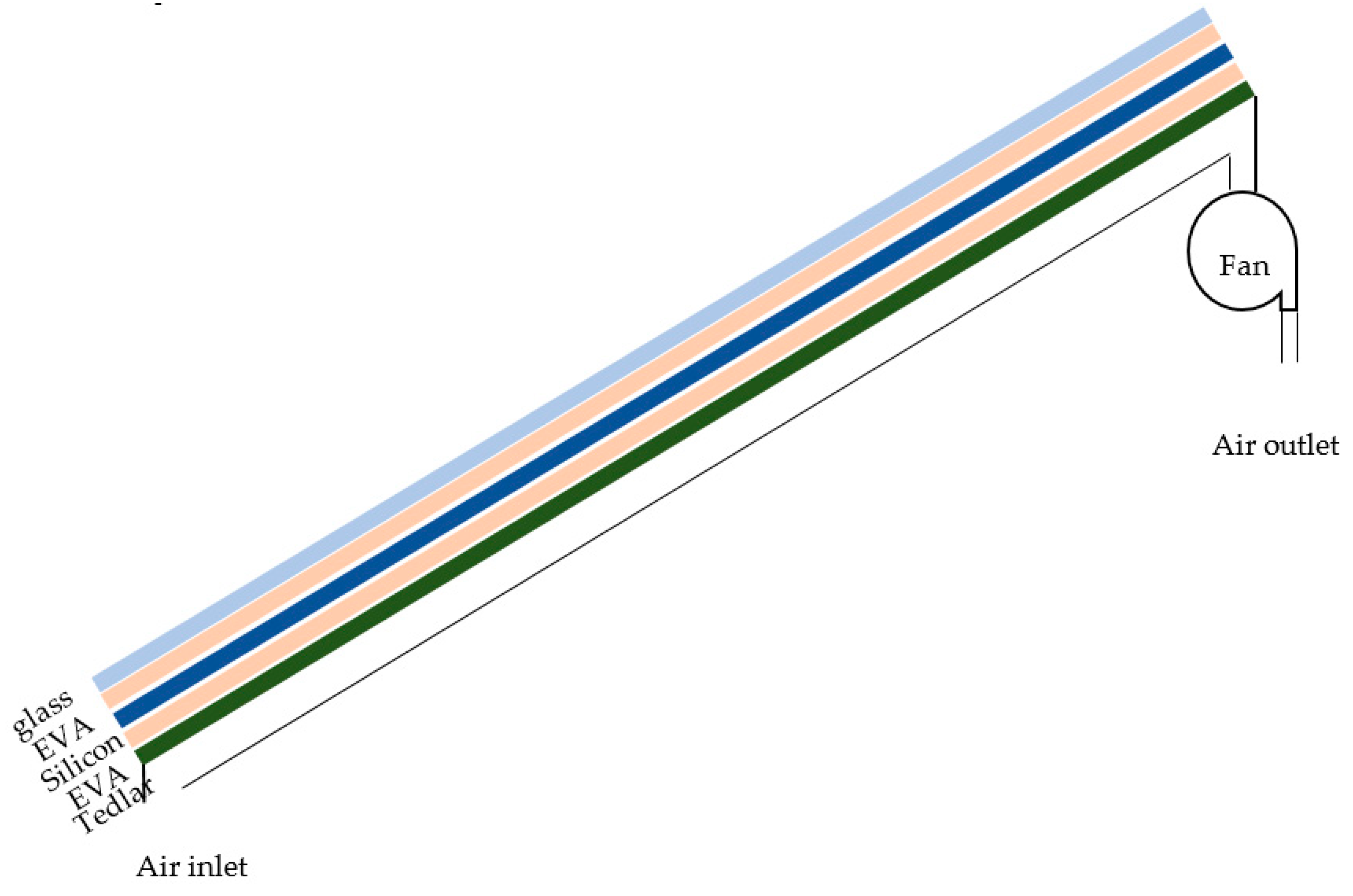


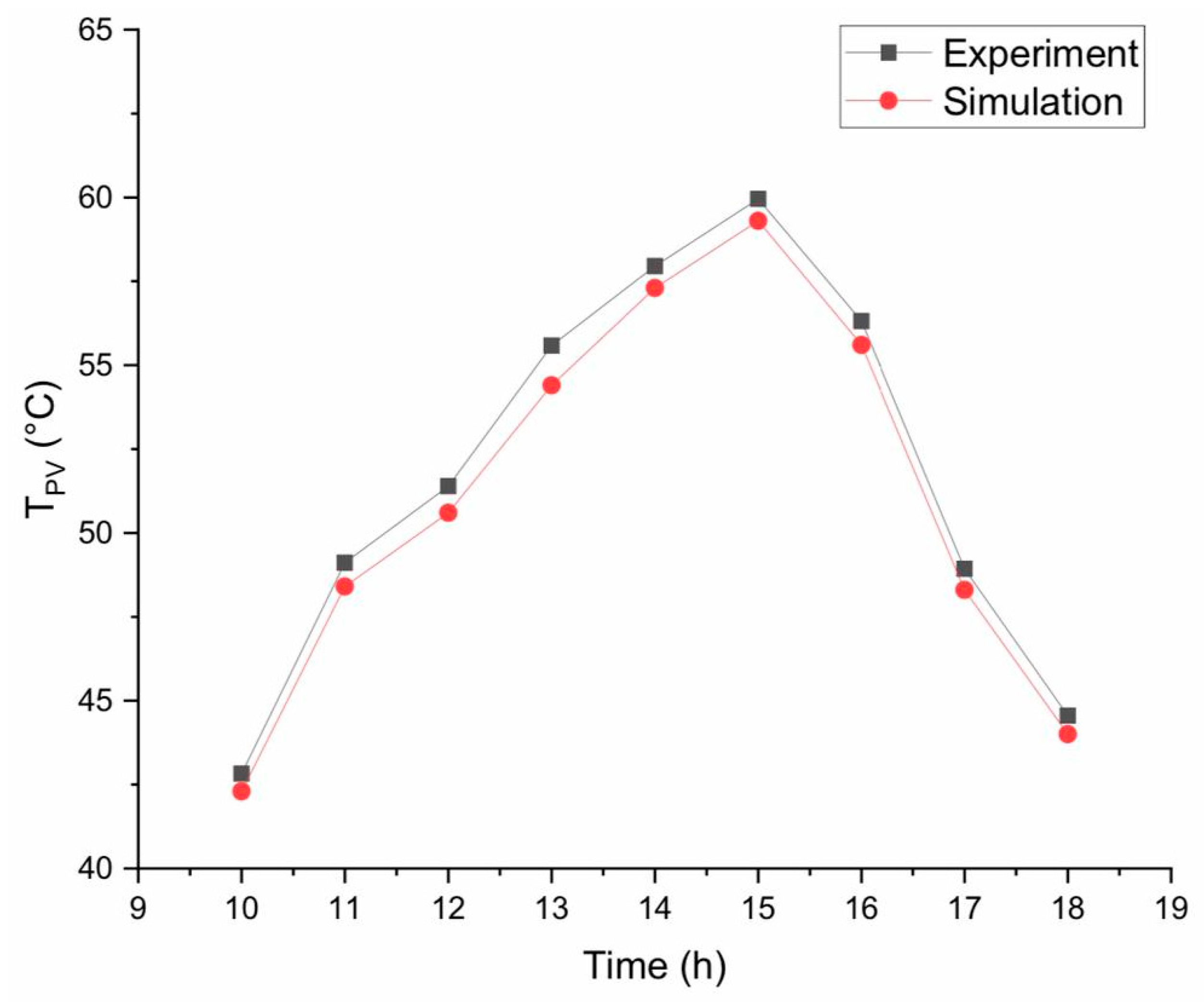
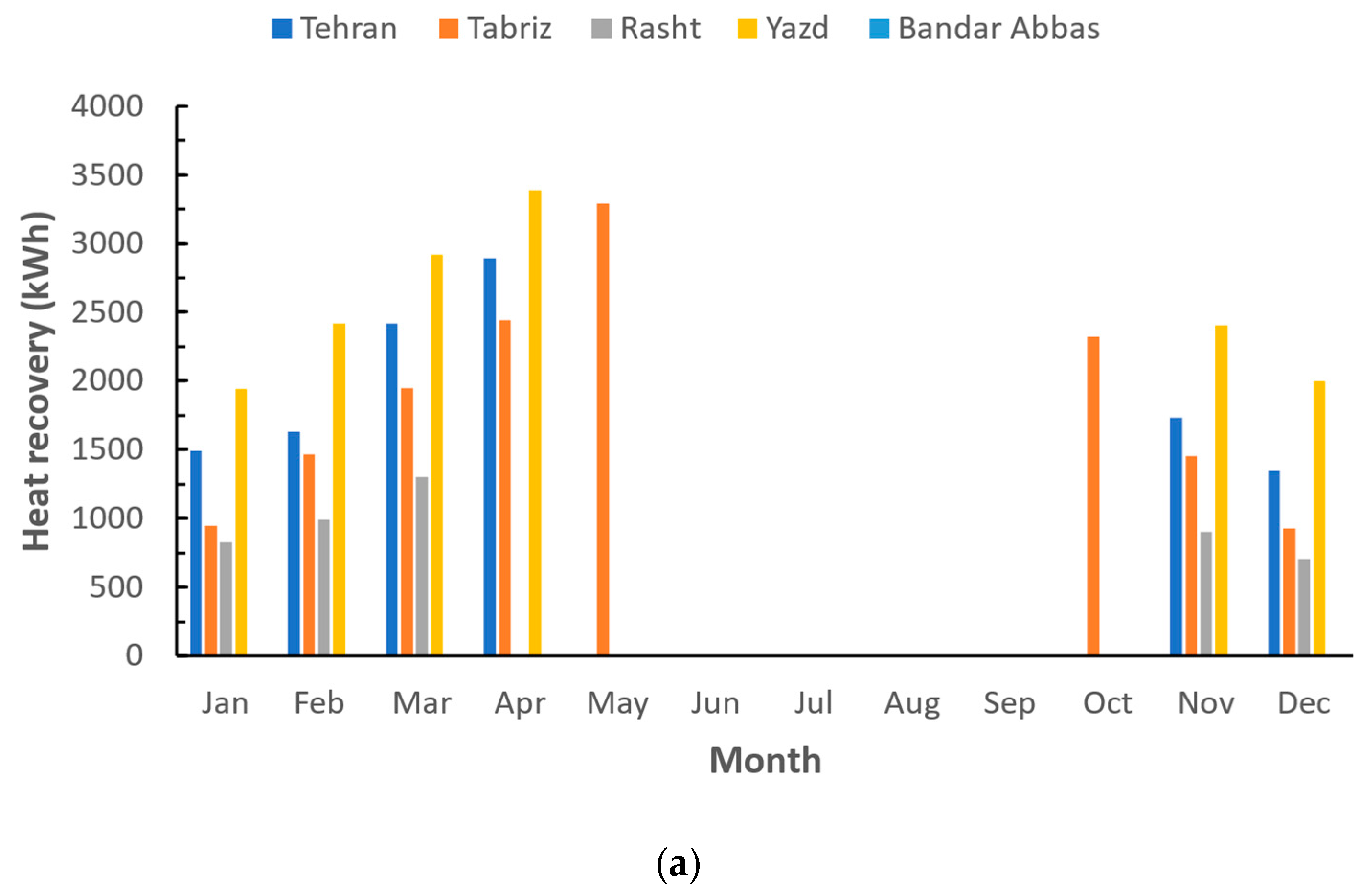

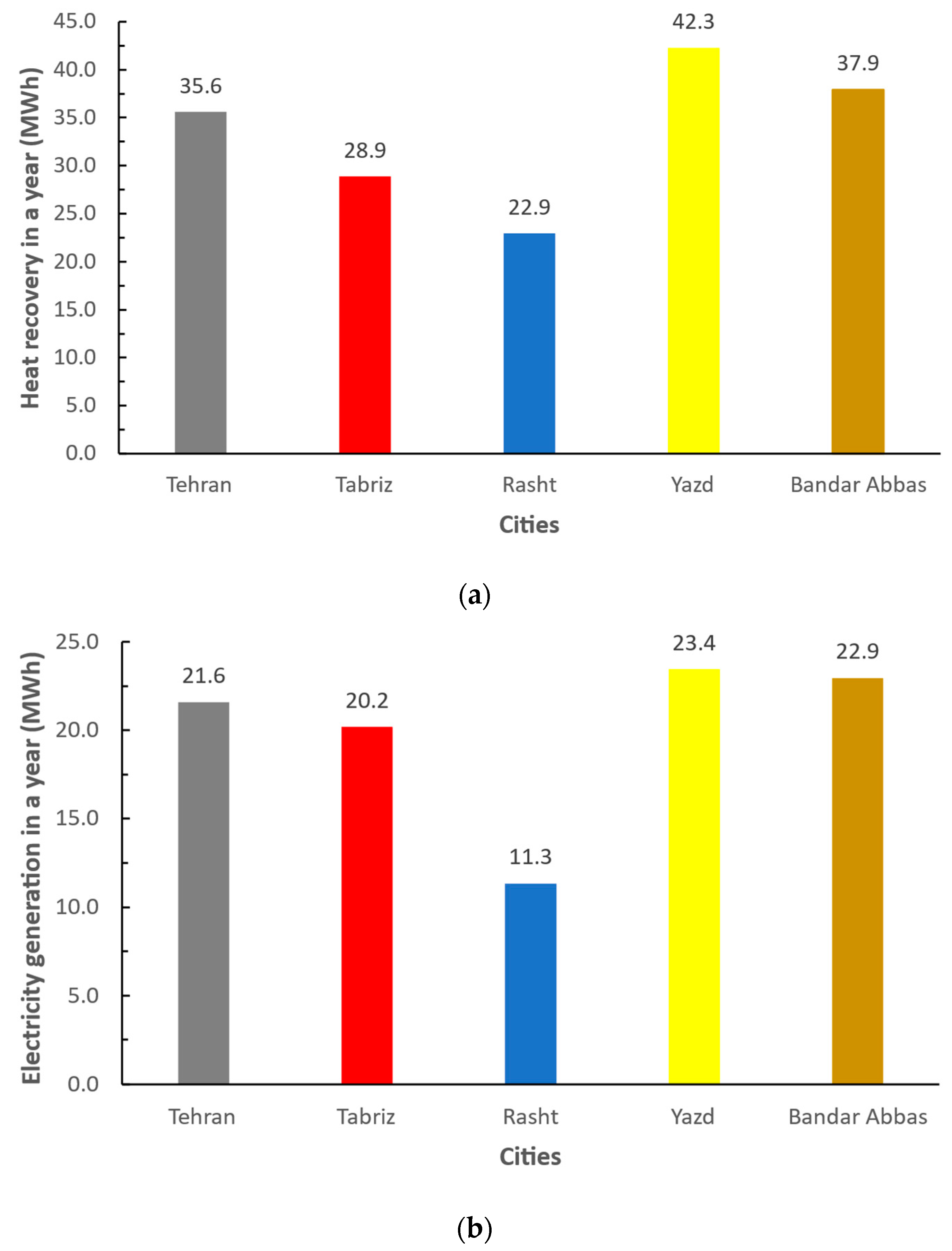
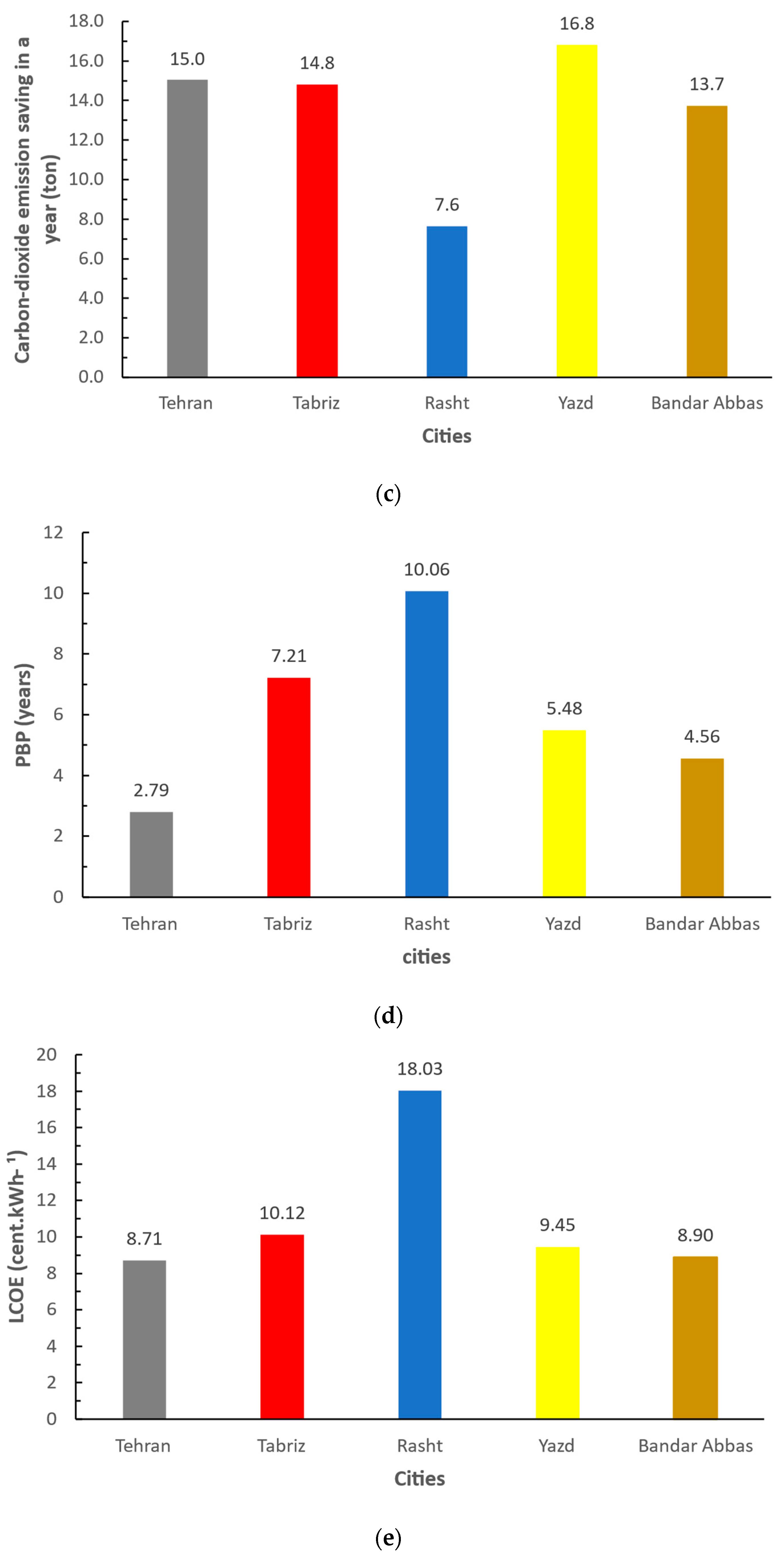
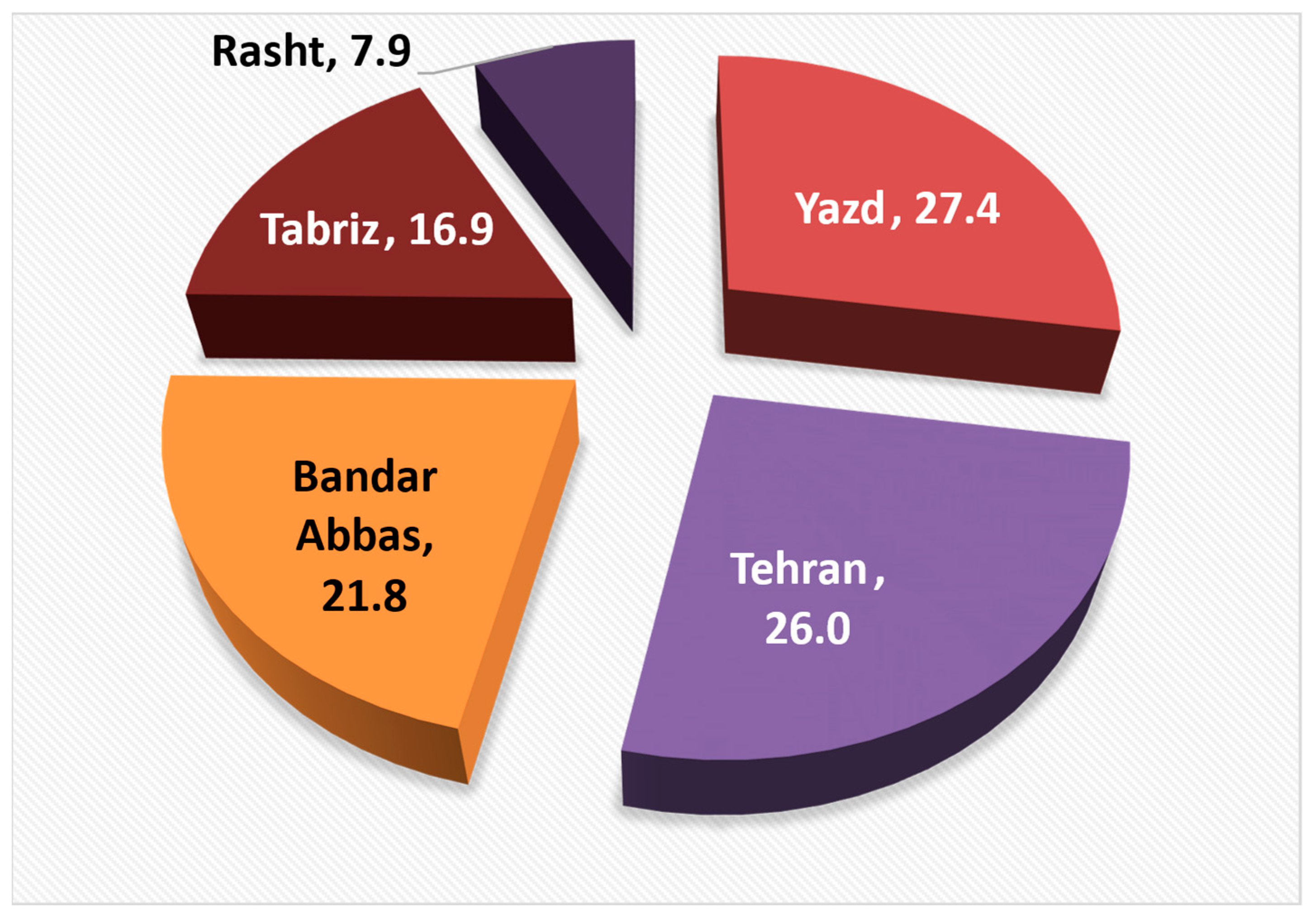
| Study | Year | A Short Description | Was a Systematic Decision-Making Approach Utilized for Selecting the Best Location for the Installation of a BIPV/T System? |
|---|---|---|---|
| Dash et al. [19] | 2018 | A model based on simple equations for heat transfer was developed and energy and exergy analyses were carried out. The study considered climatic conditions of India. | No |
| Garg [20] | 2018 | A numerical model in which the performance was assumed as a steady-state, was developed. The developed model was validated using the obtained experimental data under the climatic condition of the University of Delft, the Netherlands. | No |
| Lamnatou et al. [21] | 2019 | Life cycle assessment was carried out for a BIPV/T system in Belfast, United Kingdom. Different indicators, including ecological footprint were studied. | No |
| Kazemian et al. [22] | 2019 | A BIPV/T system performance with PCM was simulated. It was carried out by developing a 3D numerical model. A parametric analysis was carried out afterwards. | No |
| Yu et al. [23] | 2020 | A review on the design and performance assessment of BIPV/T systems was conducted. | No |
| Jahangir et al. [24] | 2020 | A novel design for application of PCM in a BIPV/T system was proposed. Four types of PCM were examined, while the case study was located in Mashhad, Iran. | No |
| Shakouri et al. [25] | 2020 | By developing a quasi-static model, the performance of a BIPV/T was simulated to improve the energy aspect. The study considered Middle Eastern climatic conditions for analysis. | No |
| Bot et al. [26] | 2020 | A numerical simulation was carried out to model a BIPV/T system in the Mediterranean climate. A variety of indicators, including thermal comfort, were studied. | No |
| Kumar et al. [27] | 2021 | The study focused on energy losses in a BIPV/T system. Two indicators, namely, cumulative and partial performance ratios, were considered. The study selected Malaysia as the case study, which was representative of the tropical climate. | No |
| Rounis et al. [28] | 2021 | A BIPV/T was designed, developed, and experimentally tested, and a number of performance improvement techniques, such as multiple inputs, were examined. A solar simulator was utilized for conducting the experiments. | No |
| Dumoulin et al. [29] | 2021 | An integrated system, which was a combination of a BIPV/T unit and a heat pump, was experimentally investigated using TRNSYS software. The goal of the study was to find the enhancement potential of the system due to the application of storage units, while Montreal, Canada, was the considered case study. | No |
| Ma et al. [30] | 2021 | A region in the northern part of Canada was considered, and the feasibility of BIPV/T system application for that was investigated. The investigation was carried out to optimize the life cycle cost. | No |
| Asefi et al. [31] | 2021 | A review was conducted with the aim of comparison of different technologies that have the potential of integration with a BIPV/T system. | No |
| Gagliano et al. [32] | 2021 | The operation of a BIPV in the Mediterranean region was investigated by developing a validated simulation approach. The energy production values for diverse exposures were obtained and compared together. | No |
| Maghrabie et al. [33] | 2021 | This study investigated different challenges towards using BIPV/T systems, including technical, economic, and environmental perspectives. | No |
| Sohani et al. [2] | 2022 | A BIPV/T PCM system in Tehran, Iran, was studied to find the best value of PCM. It was carried out using the dynamic multi-objective optimization approach. | No |
| The current study | 2022 | Five cities from diverse climatic conditions of Iran are chosen, and by taking advantage of TOPSIS, the preference for installation of BIPV/T systems is found for a residential building as the case-study. The investigation covers environmental, energy, and economic indicators. | Yes |
| Bandar Abbas | Tabriz | Tehran | Rasht | Yazd | ||
|---|---|---|---|---|---|---|
| Climate type | Hot and humid | Cold and dry | Hot Semi desert | Temperate and humid | Hot and dry | |
| Latitude (°N) | 27.2 | 37.8 | 35.7 | 37.3 | 31.9 | |
| Longitude (°E) | 56.4 | 46.3 | 51.4 | 50.2 | 54.4 | |
| Summer | Tdb (°C) | 40.6 | 33.9 | 37.8 | 31.9 | 40 |
| Twb (°C) | 31.9 | 18 | 19.4 | 25.7 | 18.3 | |
| Winter | Tdb (°C) | 7.5 | −10.8 | −4.4 | −2.2 | −5.3 |
| Parameter | Value | Unit |
|---|---|---|
| Module type | Silicon-based polycrystalline (YL320P-35b) | - |
| The rated capacity of each module | 320 | |
| Manufactured by | Yingly Company | - |
| Air gap | 150 | mm |
| Thickness of each module | 40 | mm |
| Width of each module | 992 | mm |
| Length of each module | 1960 | mm |
| Building height | 18 | m |
| Temperature factor of maximum power | −0.45 | %.K−1 |
| Current in short-circuit state | 9.25 | A |
| Current in maximum power state | 8.78 | A |
| Voltage in open-circuit state | 45.2 | V |
| Temperature factor of voltage | −0.37 | %.K−1 |
| Voltage in maximum power state | 36.5 | V |
Publisher’s Note: MDPI stays neutral with regard to jurisdictional claims in published maps and institutional affiliations. |
© 2022 by the authors. Licensee MDPI, Basel, Switzerland. This article is an open access article distributed under the terms and conditions of the Creative Commons Attribution (CC BY) license (https://creativecommons.org/licenses/by/4.0/).
Share and Cite
Shahverdian, M.H.; Sedayevatan, S.; Latif Damavandi, S.; Sohani, A.; Sayyaadi, H. A Road Map to Detect the Foremost 3E Potential Areas for Installation of PV Façade Technology Using Multi-Criteria Decision Making. Sustainability 2022, 14, 15529. https://doi.org/10.3390/su142315529
Shahverdian MH, Sedayevatan S, Latif Damavandi S, Sohani A, Sayyaadi H. A Road Map to Detect the Foremost 3E Potential Areas for Installation of PV Façade Technology Using Multi-Criteria Decision Making. Sustainability. 2022; 14(23):15529. https://doi.org/10.3390/su142315529
Chicago/Turabian StyleShahverdian, Mohammad Hassan, Saba Sedayevatan, Sajjad Latif Damavandi, Ali Sohani, and Hoseyn Sayyaadi. 2022. "A Road Map to Detect the Foremost 3E Potential Areas for Installation of PV Façade Technology Using Multi-Criteria Decision Making" Sustainability 14, no. 23: 15529. https://doi.org/10.3390/su142315529
APA StyleShahverdian, M. H., Sedayevatan, S., Latif Damavandi, S., Sohani, A., & Sayyaadi, H. (2022). A Road Map to Detect the Foremost 3E Potential Areas for Installation of PV Façade Technology Using Multi-Criteria Decision Making. Sustainability, 14(23), 15529. https://doi.org/10.3390/su142315529








